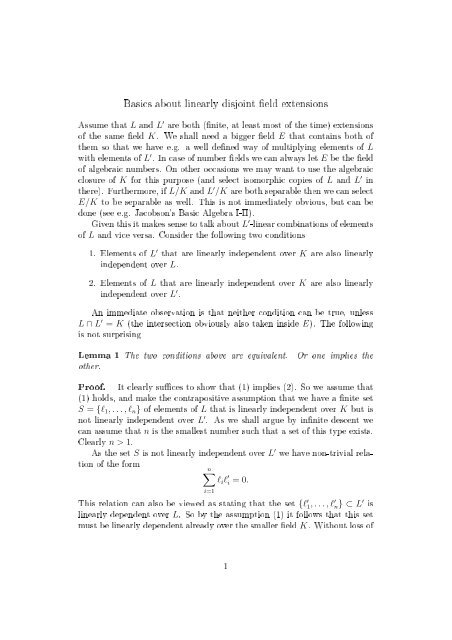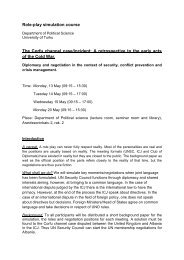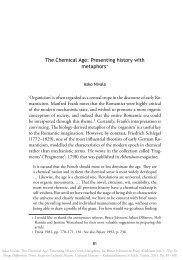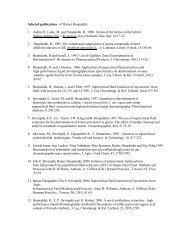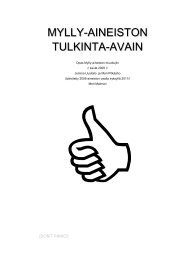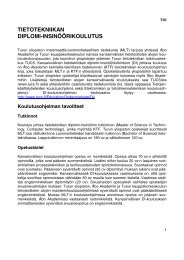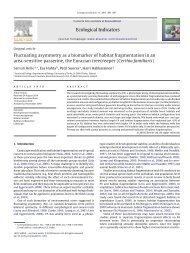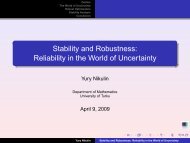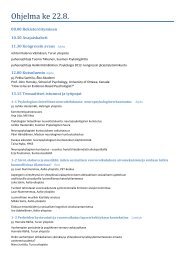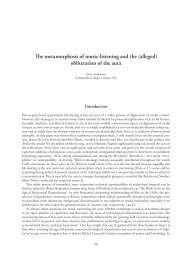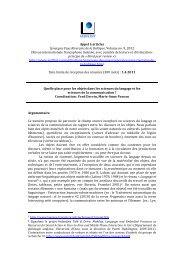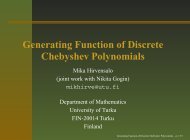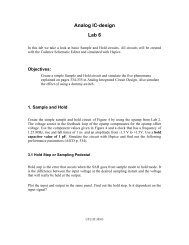Basics about linearly disjoint field extensions
Basics about linearly disjoint field extensions
Basics about linearly disjoint field extensions
You also want an ePaper? Increase the reach of your titles
YUMPU automatically turns print PDFs into web optimized ePapers that Google loves.
<strong>Basics</strong> <strong>about</strong> <strong>linearly</strong> <strong>disjoint</strong> eld <strong>extensions</strong>Assume that L and L ′ are both (nite, at least most of the time) <strong>extensions</strong>of the same eld K. We shall need a bigger eld E that contains both ofthem so that we have e.g. a well dened way of multiplying elements of Lwith elements of L ′ . In case of number elds we can always let E be the eldof algebraic numbers. On other occasions we may want to use the algebraicclosure of K for this purpose (and select isomorphic copies of L and L ′ inthere). Furthermore, if L/K and L ′ /K are both separable then we can selectE/K to be separable as well. This is not immediately obvious, but can bedone (see e.g. Jacobson's Basic Algebra I-II).Given this it makes sense to talk <strong>about</strong> L ′ -linear combinations of elementsof L and vice versa. Consider the following two conditions1. Elements of L ′ that are <strong>linearly</strong> independent over K are also <strong>linearly</strong>independent over L.2. Elements of L that are <strong>linearly</strong> independent over K are also <strong>linearly</strong>independent over L ′ .An immediate observation is that neither condition can be true, unlessL ∩ L ′ = K (the intersection obviously also taken inside E). The followingis not surprisingLemma 1 The two conditions above are equivalent. Or one implies theother.Proof. It clearly suces to show that (1) implies (2). So we assume that(1) holds, and make the contrapositive assumption that we have a nite setS = {l 1 , . . . , l n } of elements of L that is <strong>linearly</strong> independent over K but isnot <strong>linearly</strong> independent over L ′ . As we shall argue by innite descent wecan assume that n is the smallest number such that a set of this type exists.Clearly n > 1.As the set S is not <strong>linearly</strong> independent over L ′ we have non-trivial relationof the formn∑l i l ′ i = 0.i=1This relation can also be viewed as stating that the set {l ′ 1, . . . , l ′ n} ⊂ L ′ is<strong>linearly</strong> dependent over L. So by the assumption (1) it follows that this setmust be <strong>linearly</strong> dependent already over the smaller eld K. Without loss of1
generatlity we can assume that l ′ n can be written as a K-linear combinationof the others, so we can nd constants a i ∈ K such that∑n−1l ′ n = a i l ′ i.i=1Putting these two together we arrive at the relation∑n−1(l i + a i l n )l ′ i = 0.i=1The set S a = {l 1 +a 1 l n , . . . , l n−1 +a n−1 l n } is thus <strong>linearly</strong> dependent overL ′ . But it is clearly <strong>linearly</strong> independent over K, because S was assumed tobe. Therefore we have violated the minimality of n, and the claim follows.Denition 0.1 Two extension elds L and L ′ of K are said to be <strong>linearly</strong><strong>disjoint</strong>, if they satisfy either (and hence both) of the conditions (1) and/or(2).Example 1 This example shows that linear <strong>disjoint</strong>ness is not equivalent tothe condition L∩L ′ = K. Let α and β be two cubic roots of 2. Let L = Q(α)and L ′ = Q(β), so L ∩ L ′ = Q = K. Then ω = α/β is a primitive third rootof unity, so it satises the equation 1+ω+ω 2 = 0. Clearing the denominatorsgives us the relationα 2 + αβ + β 2 = 0.This shows that the Q-basis {1, α, α 2 } is <strong>linearly</strong> dependent over L ′ , and alsoshows that the Q-basis {1, β, β 2 } is <strong>linearly</strong> dependent over L.From now on assume that [L : K] and [L ′ : K] are nite. Dene the setof nite sums of productsLL ′ = {n∑l i l ′ i | l i ∈ L, l ′ i ∈ L ′ , n ∈ N}.i=1Lemma 2 The set LL ′ is closed under multiplication, and so forms a ring.Proof. An exercise.Lemma 3 The dimension (over K) of the set LL ′ is bounded from above by[L : K][L ′ : K].2


